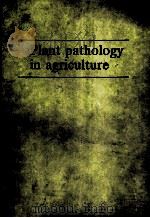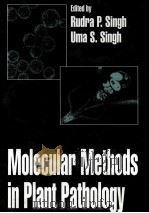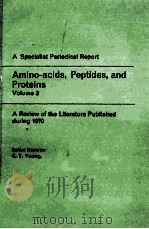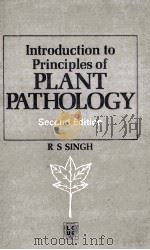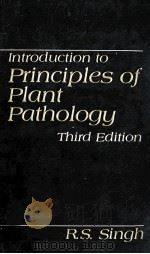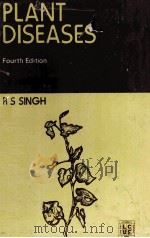《plant pathology fourth edition P635》
| 作者 | 编者 |
|---|---|
| 出版 | 未查询到或未知 |
| 参考页数 | |
| 出版时间 | 没有确切时间的资料 目录预览 |
| ISBN号 | 无 — 求助条款 |
| PDF编号 | 820559978(仅供预览,未存储实际文件) |
| 求助格式 | 扫描PDF(若分多册发行,每次仅能受理1册) |
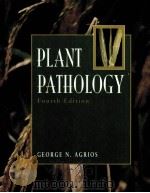
part one GENERAL ASPECTS3
chapter oneINTRODUCTION3
Plant Pathology: The Science3
The Concept of Disease in Plants4
Types of Plant Diseases4
History of Plant Pathology7
The Role o f Fungi in Plant Disease10
Discovery o f Other Pathogens as Causes of Plant Disease12
Serious Plant Diseases o f Unknown Etiology13
Early Development o f Plant Pathology13
The Search for Control o f Plant Diseases14
Interest in the Mechanisms by Which PathogensCause Disease17
The Concept o f Genetic Inheritance o f Resistance and Pathogenicity18
Epidemiology o f Plant Disease Comes o f Age19
Molecular Plant Pathology19
Development o f Plant Pathology Worldwide20
Trends in Teaching and Training in Plant Pathology22
Education and Information Technology in Plant Pathology23
Plant Disease Clinics23
Plant Pathology: The Practice23
Certification of Professional Plant Pathologists25
Significance of Plant Diseases25
Kinds and Amounts o f Losses25
Some Historical and Present Examples of Losses Caused by Plant Diseases28
Plant Diseases and World Crop Production28
Effects o f Changes in Agricultural Methods and in Human Society on the Development and Spread of Plant Diseases34
Basic Procedures in the Diagnosis of Plant Diseases37
Pathogen or Environment?37
Infectious Diseases37
Noninfectious Diseases39
Identification of a Previously Unknown Disease:Koch’s Rules39
chapter two PARASITISM AND DISEASE DEVELOPMENT43
Parasitism and Pathogenicity43
Host Range of Pathogens44
Development of Disease in Plants45
Stages in the Development of Disease:The Disease Cycle45
Inoculation45
Prepenetration Phenomena46
Penetration48
Infection53
Invasion54
Growth and reproduction of the pathogen(colonization)54
Dissemination o f the Pathogen56
Overwintering and/or Oversummering of Pathogens59
Relationships between Disease Cycles and Epidemics61
chapter three HOW PATHOGENS ATTACK PLANTS63
Mechanical Forces Exerted by Pathogens on Host Tissues63
Chemical Weapons of Pathogens65
Enzymes in Plant Disease65
Microbial Toxins in Plant Disease73
Growth Regulators in Plant Disease77
Polysaccharides81
Suppressors of Plant Defense Responses81
chapter four EFFECTS OF PATHOGENS ON PLANT PHYSIOLOGICAL FUNCTIONS83
Effects of Pathogens on Photosynthesis83
Effect of Pathogens on Translocation of Water and Nutrients in the Host Plant85
Interference with Upward Translocation o f Water and Inorganic Nutrients85
Interference with the Translocation o f Organic Nutrients through the Phloem86
Effect of Pathogens on Host Plant Respiration87
Respiration o f Diseased Plants88
Effect of Pathogens on Permeability of Cell Membranes89
Effects of Pathogens on Transcription and Translation90
Effect on Transcription90
Effect on Translation91
chapter five HOW PLANTS DEFEND THEMSELVES AGAINST PATHOGENS93
Preexisting Structural and Chemical Defenses93
Preexisting Defense Structures93
Preexisting Chemical Defenses94
Induced Structural and Biochemical Defenses96
Recognition o f the Pathogen by the Host Plant96
Transmission o f the Alarm Signal to Host Defense Providers: Signal Transduction96
Induced Structural Defenses96
Cytoplasmic defense reaction97
Cell wall defense structures97
Histological defense structures98
Necrotic defense reaction:defense through the hypersensitive response100
Induced Biochemical Defenses100
The hypersensitive response100
Active oxygen radicals,lipoxygenases,and disruption of cell membranes103
Reinforcement of host cell walls with strengthening molecules103
Production of antimicrobial substances in attacked host cells104
Detoxification of pathogen toxins108
Immunization of plants against pathogens108
Local and systemic acquired resistance108
Defense through genetically engineering disease resistant plants112
chapter six GENETICS OF PLANT DISEASE115
Introduction115
Genes and Disease116
Variability in Organisms117
Mechanisms of Variability118
General Mechanisms of Variability118
Specialized Mechanisms of Variability in Pathogens119
Stages of Variation in Pathogens121
Types of Plant Resistance to Pathogens122
True Resistance122
Apparent Resistance124
Genetics of Virulence in Pathogens and of Resistance in Ho st Plants125
The Gene-for-Gene Concept126
The Nature o f Resistance to Disease128
Genetics of Resistance through the Hypersensitive Response129
Breeding of Resistant Varieties135
Natural Variability in Plants135
Effects o f Plant Breeding on Variability in Plants135
Plant Breeding for Disease Resistance136
chapter seven ENVIRONMENTAL EFFECTS ON THE DEVELOPMENT OF INFECTIOUS PLANT DISEASE144
Effect of Temperature144
Effect of Moisture146
Effect of Wind148
Effect of Light149
Effect of Soil pH and Soil Structure149
Effect of Host-Plant Nutrition149
Effect of Herbicides151
chapter eight PLANT DISEASE EPIDEMIOLOGY153
The Elements of an Epidemic153
Host Factors That Affect the Development of Epidemics155
Pathogen Factors That Affect Development of Epidemics156
Environmental Factors That Affect Development of Epidemics158
Effect o f Human Cultural Practices and Control Measures158
Measurement of Plant Disease and of Yield Loss159
Patterns of Epidemics160
Comparison of Epidemics162
Development of Epidemics163
Modeling of Plant Disease Epidemics165
Computer Simulation of Epidemics166
Forecasting Plant Disease Epidemics167
Assessment o f Initial Inoculum and of Disease167
Monitoring Weather Factors That Affect Disease Development167
Examples o f Plant Disease Forecast Systems168
Disease-Warning Systems170
Development and Use o f Expert Systems in Plant Pathology171
chapter nine CONTROL OF PLANT DISEASES174
Control Methods That Exclude the Pathogen from the Host174
Quarantines and Inspections174
Evasion or Avoidance of Pathogen175
Use o f Pathogen-Free Propagating Material175
Control Methods That Eradicate or Reduce Pathogen Inoculum177
Cultural Methods That Eradicate or Reduce the Inoculum178
Biological Methods That Eradicate or Reduce the Inoculum181
Physical Methods That Eradicate or Reduce the Inoculum188
Chemical Methods That Eradicate or Reduce the Inoculum190
Disease Control by Immunizing, or Improving the Resistance of, the Host192
Cross Protection193
Induced Resistance:Systemic Acquired Resistance193
Plant Defense Activators193
Improving the Growing Conditions of Plants194
Use o f Resistant Varieties194
Direct Protection of Plants from Pathogens195
Direct Protection by Biological Controls195
Fungal antagonists 196;Bacterial antagonists197
Biological Control of Weeds199
Direct Protection by Chemical Controls200
Methods of application of chemicals for plant disease control203
Types of chemicals used for plant disease control208
Inorganic chemicals used for plant disease control208
Organic chemicals:contact protective fungicides209
Organic compounds: systemic fungicides210
Miscellaneous organic fungicides212
Antibiotics212
Plant oils and petroleum oils213
Growth regulators213
Nematicides213
Mechanisms of action of chemicals used to control plant diseases214
Resistance of pathogens to chemicals215
Restrictions on chemical control of plant diseases216
Integrated Control of Plant Diseases216
Integrated Control in a Perennial Crop217
Integrated Control in an Annual Crop218
part two SPECIFIC PLANT DISEASES225
chapter ten ENVIRONMENTAL FACTORS THAT CAUSE PLANT DISEASES225
Introduction225
General Characteristics225
Diagnosis225
Control226
Temperature Effects226
High-Temperature Effects227
Low-Temperature Effects228
Low-Temperature Effects on Indoor Plants228
Mechanisms of Low- and High-Temperature Injury to Plants230
Moisture Effects230
Low Soil Moisture Effects230
Low Relative Humidity Effects231
High Soil Moisture Effects231
Inadequate Oxygen232
Light232
Air Pollution233
Air Pollutants and Kinds of injury to Plants233
Main Sources o f Air Pollutants234
How Air Pollutants Affect Plants234
Acid Rain236
Nutritional Deficiencies in Plants236
Soil Minerals Toxic to Plants238
Herbicide Injury240
Other Improper Agricultural Practices241
The Often Confused Etiology of Stress Diseases242
chapter eleven PLANT DISEASE CAUSED BY FUNGI245
Introduction245
Characteristics of Plant Pathogenic Fungi245
Morphology245
Reproduction246
Ecology246
Dissemination248
Classification of Plant Pathogenic Fungi248
Fungallike Organisms or Pseudofungi248
The True Fungi249
Identification254
Symptoms Caused by Fungi on Plants254
Isolation o f Fungi (and Bacteria)255
Preparing for Isolation255
Isolating the Pathogen257
Life Cycles of Fungi258
Control of Fungal Diseases of Plants259
Diseases Caused by Fungallike Organisms260
Diseases Caused by Myxomycota (Myxomycetes)260
Diseases Caused by Plasmodiophoromycetes263
Clubroot of crucifers263
Diseases Caused by the Chromistan Fungallike Oomycetes266
Pythium Seed Rot,Damping-off, Root Rot,and Soft Rot266
Phytophthora Diseases270
Phytophthora root and stem rots270
Late blight of potatoes274
The Downy Mildews278
Downy mildew of grape280
Diseases Caused by True Fungi283
Diseases Caused by Chytridiomycota(Chytridiomycetes)283
Diseases Caused by Zygomycetes283
Rhizopus soft rot of fruits and vegetables285
Diseases Caused by Ascomycetes and Imperfect (Asexual)Fungi286
Sooty Molds289
Leaf Curl Diseases Caused by Tapbrina293
The Powdery Mildews295
Powdery mildew of rose297
Foliar Diseases Caused by Ascomycetes and Imperfect Fungi298
Alternaria diseases300
Rice blast disease303
Black rot of grape304
Needle casts and blights of conifers304
Mycospbaerella diseases307
Banana leaf spot,or Sigatoka disease307
Cucurbit gummy stem blight307
Cerospora diseases309
Septoria diseases310
Cochliobolus and Pyrenophora diseases of cereals and grasses310
Stem and Twig Cankers Caused by Ascomycetes and Imperfect Fungi317
Dothichiza canker of poplar318
Black knot of plum and cherry319
Chestnut blight319
Nectria canker319
Leucostoma canker321
Antbracnose Diseases Caused by Ascomycetes and Imperfect Fungi324
Black spot of rose324
Glomerella diseases325
Gnomonia anthracnose and leaf spot diseases328;Colletotrichum (Gloeosporium) diseases329
Fruit and General Diseases Caused by Ascomycetes and Imperfect Fungi331
Ergot of cereals and grasses332
Apple scab334
Brown rot of stone fruits336
Botrytis diseases339
Vascular Wilts Caused by Ascomycetes and Imperfect Fungi342
Fusarium wilts343
Fusarium wilt of tomato343
Verticillium wilts346
Ophiostoma (Ceratocystis)wilt of elm trees:Dutch elm disease346
Root and Stem Rots Caused by Ascomycetes and Imperfect Fungi350
Gibberella diseases351
Fusarium root and stem rots of nongrain crops352
Take-all of wheat354
Sclerotinia diseases355
Pbymatotrichum root rot358
Postharvest Diseases o f Plant Products Caused by Ascomycetes and Imperfect Fungi359
Postharvest decays of fruits and vegetables361
Alternaria361
Botrytis362
Fusarium,Geotrichuni,Penicillium,Sclerotinia363
Control of postharvest decays of fresh fruits and vegetables364
Postharvest decays of grain and legume seeds364;Mycotoxins and mycotoxicoses365; Aflatoxins365
Fusarium toxins366
Other Aspergillus toxins andPenicillium toxins366
Diseases Caused by Basidiomycetes368
The Rusts368
Cereal rusts371
Stem rust of wheat and other cereals371
Cedar-apple rust375
Coffee rust375
Rusts of forest trees377
White pine blister rust378
Fusiform rust380
The Smuts382
Corn smut382
Kernel smuts of small grains384
Loose smut of cereals384
Covered smut,or bunt,of wheat387
Root and Stem Rots Caused by Basidiomycetes389
Root and stem rot diseases caused by the “sterile fungi”Rhizoctonia and Sclerotium390
Rhizoctonia diseases390
Sclerotium diseases395
Root rots of trees397
Armillaria root rot of fruit and forest trees397
Wood Rots and Decays Caused by Basidiomycetes399
Mycorrhizae404
Ectomycorrhizae404
Endonnycorrhizae404
chapter twelve PLANT DISEASES CAUSED BY PROKARYOTES:BACTERIA AND MOLLICUTES407
Introduction407
Plant Diseases Caused by Bacteria408
Characteristics of Plant Pathogenic Bacteria409
Morphology409
Reproduction411
Ecology and Spread412
Identification of Bacteria412
Symptoms Caused by Bacteria415
Control o f Bacterial Diseases of Plants415
Bacterial Spots and Blights416
Wildfire of tobacco417
Bacterial blights of bean418
Angular leaf spot of cucumber419
Angular leaf spot of cotton420
Bacterial leaf spots and blights of cereals and grasses421
Bacterial spot of tomato and pepper421
Bacterial speck of tomato422
Bacterial spot of stone fruits422
Bacterial Vascular Wilts423
Bacterial wilt of cucurbits424
Fire blight of pear and apple426
Ring rot of potato429
Bacterial canker and wilt of tomato430
Southern bacterial wilt of solanaceous plants and Moko disease of banana431
Black rot of crucifers433
Bacterial Soft Rots434
Bacterial soft rots of vegetables435
Bacterial Galls438
Crown gall438
Bacterial Cankers441
Bacterial canker and gummosis of stone fruit trees442
Citrus canker445
Bacterial Scabs449
Common scab of potato449
Root Nodules of Legumes451
Plant Diseases Caused by Fastidious Vascular Bacteria453
Pierce’s disease of grape455
Citrus variegated chlorosis456
Ratoon stunting of sugarcane456
Plant Diseases Caused by Mollicutes:Phytoplasmas and Spiroplasmas457
Properties of True Mycoplasmas457
Phytoplasmas458
Spiroplasmas460
Other Organisms That Resemble Mollicutes:L-Forms of Bacteria462
Examples of Plant Diseases Caused by Mollicutes462
Aster yellows462
Lethal yellowing of coconut palms464
Elm yellows(phloem necrosis)465
Peach X-disease465
Pear decline467
Citrus stubborn disease467
Corn stunt disease469
chapter thirteen PLANT DISEASES CAUSED BY PARASITIC HIGHER PLANTS471
Introduction471
Dodder471
Witchweed473
Broomrapes475
Dwarf Mistletoes of Conifers475
True or Leafy Mistletoes477
chapter fourteen PLANT DISEASES CAUSED BY VIRUSES479
Introduction479
Characteristics of Plant Viruses479
Detection480
Morphology480
Composition and Structure480
Satellite Viruses and Satellite RNAs484
The Biological Function of Viral Components:Coding485
Virus Infection and Virus Synthesis485
Translocation and Distribution of Viruses in Plants488
Symptoms Caused by Plant Viruses489
Physiology of Virus-Infected Plants491
Transmission of Plant Viruses491
Transmission of Viruses by Vegetative Propagation492
Mechanical Transmission o f Viruses through Sap492
Seed Transmission494
Pollen Transmission494
Insect Transmission494
Mite Transmission495
Nematode Transmission495
Fungus Transmission496
Dodder Transmission496
Epidemiology of Plant Viruses and Viroids496
Purification of Plant Viruses497
Serology of Plant Viruses497
Nomenclature and Classification of Plant Viruses500
Detection and Identification of Plant Viruses503
Economic Importance of Plant Viruses505
Control of Plant Viruses505
Diseases Caused by Rigid Rod-Shaped Viruses508
Diseases Caused by Tobamoviruses:Tobacco Mosaic Virus508
Diseases Caused by Tobraviruses510
Diseases Caused by Furoviruses510
Diseases Caused by Hordeiviruses511
Diseases Caused by Filamentous Viruses512
Diseases Caused by Potexviruses512
Diseases Caused by Carlaviruses512
Diseases Caused by Capilloviruses and Trichoviruses512
Diseases Caused by Potyviridae513
Diseases Caused by Potyviruses513
Bean common mosaic and bean yellow mosaic515
Lettuce mosaic515
Papaya ringspot516
Plum pox517
Potato virus Y517
sugarcane mosaic518
Tobacco etch518
Turnip mosaic519
Watermelon mosaic519
Zucchini yellow mosaic519
Diseases Caused by Rymoviruses and Bymoviruses519
Diseases Caused by Closteroviruses519
Beet yellows519
Citrus tristeza519
Lettuce infectious yellows521
Diseases Caused by Isometric Single-Stranded RNA Viruses523
Diseases Caused by Waikaviruses523
Rice tungro523
Maize chlorotic dwarf525
Diseases Caused by Luteoviruses525
Beet western yellows525
Potato leafroll525
Barley yellow dwarf525
Diseases Caused by Comoviridae527
Diseases Caused by Comoviruses527
Diseases Caused by Nepoviruses528
Tomato ring spot528
Cherry leaf roll528
Grapevine fanleaf529
Raspberry yellow dwarf,raspberry ring spot,and raspberry leaf curl529
Diseases Caused by Brommoviridae530
Diseases Caused by Cucumoviruses530
Cucumber mosaic531
Diseases Caused by Ilarviruses532
Prunus necrotic ring spot533
Diseases Caused by Isometric Double-Stranded RNA Viruses534
Diseases Caused by Reoviridae536
Diseases Caused by Negative RNA[(一)ssRNA]Viruses538
Plant Diseases Caused by Rhabdoviruses538
Plant Diseases Caused by Tospoviruses539
Plant Diseases Caused by Tenuiviruses541
Diseases Caused by Double-Stranded DNA Viruses545
Diseases Caused by Caulimoviruses545
Diseases Caused by Badnaviruses546
Diseases Caused by Single-Stranded DNA Viruses547
Plant Diseases Caused by Geminiviruses547
Maize streak551
Beet curly top551
African cassava mosaic551
Bean golden mosaic552
Squash leaf curl553
Tomato mottle553
Tomato yellow leaf curl554
Plant Diseases Caused by Isometric Single-Stranded DNA Viruses554
Banana bunchy top555
Viroids556
Plant Diseases Caused by Viroids556
Potato spindle tuber560
Citrus exocortis560
Coconut cadang-cadang561
chapter fifteen PLANT DISEASES CAUSED BY NEMATODES565
Introduction565
Characteristics of Plant Pathogenic Nematodes565
Morphology565
Anatomy565
Life Cycles566
Ecology and Spread566
Classification568
Isolation of Nematodes569
Isolation of Nematodes from Soil569
Isolation of Nematodes from Plant Material570
Symptoms Caused by Nematodes571
How Nematodes Affect Plants571
Interrelationships between Nematodes and Other Plant Pathogens572
Control of Nematodes573
Root-Knot Nematodes:Meloidogyne574
Cyst Nematodes:Heterodera and Globodera577
Soybean cyst nematode:Heterodera glycines577
Sugar beet nematode:Heterodera schachtii579
The Citrus Nematode:Tylenchulus semipenetrans581
Lesion Nematodes:Pratylenchus581
The Burrowing Nematode:Radopbolus583
Stem and Bulb Nematode:Ditylenchus586
Seed-Gall Nematodes: Anguina588
Foliar Nematodes:Aphelencboides590
Pine Wilt and Palm Red Ring Diseases:Bursaphelenchus592
Pine wilt nematode:Bursaphelenchus xylopbilus592
Red ring nematode:Bursapbelencus cocopbilus593
Stubbly-Root Nematodes:Paratricbodorus and Tricbodorus596
chapter sixteen PLANT DISEASES CAUSED BY FLAGELLATE PROTOZOA599
Introduction599
Phloem Necrosis of Coffee601
Hartrot of Coconut Palms604
Sudden Wilt (Marchitez)of Oil Palm604
Empty Root of Cassava605
Glossary607
Index619
《plant pathology fourth edition P635》由于是年代较久的资料都绝版了,几乎不可能购买到实物。如果大家为了学习确实需要,可向博主求助其电子版PDF文件。对合法合规的求助,我会当即受理并将下载地址发送给你。
高度相关资料
-

- PATHOLOGY OF THE LUNG FOURTH EDITION VOLUME 1
- 1985 PERGAMON PRESS
-
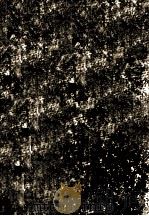
- Pathology Fourth Edition
- 1961 The C.V.Mosby Company.
-
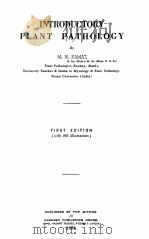
- INTRODUCTORY PLANT PATHOLOGY FIRST EDITION
- 1956 THE AUTHOR FOR PRAKASH PUBLISHING HOUSE
-
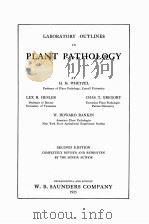
- LABORATORY OUTLINES IN PLANT PATHOLOGY SECOND EDITION
- 1925 W.B. SAUNDERS COMPANY
-

- PATHOLOGY OF TUMOURS OF THE NERVOUS SYSTEM FOURTH EDITION
- 1977 THE WILLIAMS & WILKINS COMPANY
-

- A SHORT TEXTBOOK OF CHEMICAL PATHOLOGY FOURTH EDITION
- 1982 HODDER AND STOUGHTON
提示:百度云已更名为百度网盘(百度盘),天翼云盘、微盘下载地址……暂未提供。➥ PDF文字可复制化或转WORD
